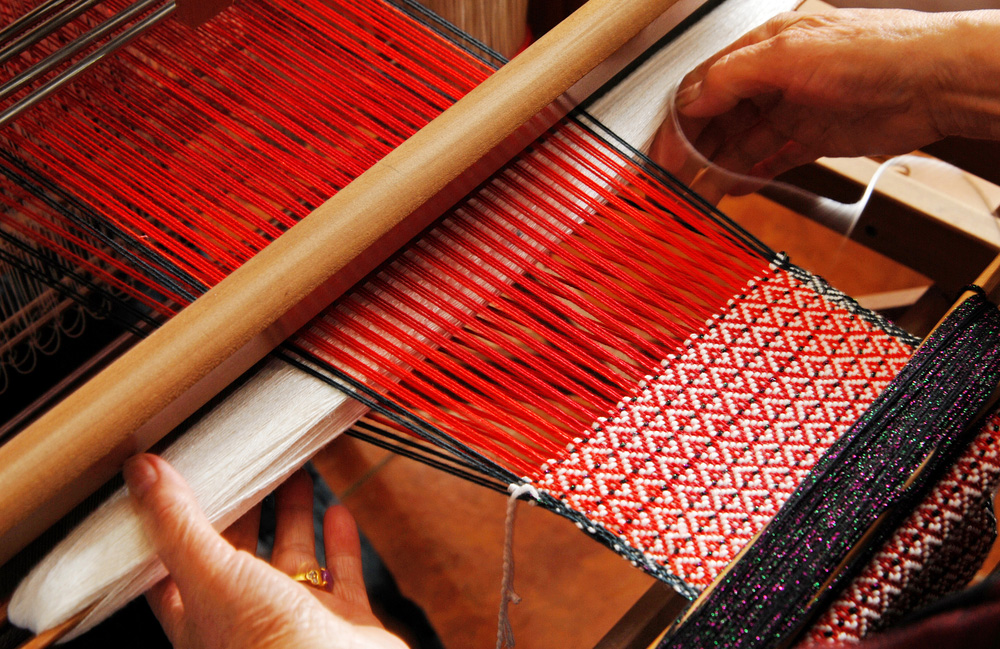India has a rich and diverse weaving tradition. Most of the traditional textile traditions use hand-spun yarn. India is known for fabrics made out of silk, cotton, and wool. Traditional handwoven textiles in India have a wide range of community expressions practiced over centuries using different manufacturing processes and craft techniques.
The present-day silk weaving tradition revolves around the sari and the kurta which is worn in most parts of the country. Silk, with its richness of texture and sheen, has led to the creation of a myriad of traditional weaving styles, with each region lending its unique flavour. The main silk weaving centres are Banaras, Surat, Chanderi, Murshidabad, Mysore, Assam, Kancheepuram, Tanjore, and Dharmavaram to name a few. While silk is the heart, cotton weaving is the soul of Indian textiles. The Indian hand-spun, hand-woven natural fibre cloth where fibres are spun into yarn on a spinning wheel called a charkha. It is a wonderfully versatile fabric, cool in summer and warm in winter.
Weaving has been a part of the Indian culture for thousands of years. Every region has distinct weaving techniques, reflecting their own culture and tradition passed down through generations. From Madhya Pradesh’s finest Chanderi to Gujarat’s exquisite Patola, from Himachal Pradesh’s Kinnauri shawls to West Bengal’s Jamdani, Muga Silk from Assam to Madras Checks from Tamilnadu, Kota Doria from Rajasthan to Mangalgiri from Andhra Pradesh, Ikat from Odisha to Lepcha from Sikkim, each tells a distinct story. Due to its rich heritage, intricate designs, natural yarns and dyeing techniques, Indian textiles have gained immense global popularity. Unique to each geographical community within the country, this diversity in textiles and artistry of artisans and craftsmen is unmatched elsewhere.
Despite the magnitude and importance of the handloom sector, hand craftsmanship is on the decline. There are many textiles — in fact some of my favourites like Telia Rumal and Mashru, which are being lost to time. Globalisation coupled with fast fashion led to a fall in the demand of traditional designs and fabric in the domestic market over the decades. The share of western wear in the Indian market rose and that of traditional garments fell dramatically in the last few years leading to a decline in the demand for Indian handloom products. This also resulted in loss of livelihoods among the rural artisan population.
The weaving and handloom industry of India reflects the glorious history and legacy of the country. Now is the time to take steps to preserve the rich textile legacy of India for the future generations. The groundwork for revival requires numerous strategies to bring these artisanal techniques to the forefront and adjusting to the pattern of modern consumption. India holds a unique position as the fashion industry shifts towards a more sustainable future. Sustainability in fashion goes beyond just using eco-friendly yarns; it means promoting the well-being of people, livelihoods, communities, and the environment.
Sustainable fashion helps to protect the environment, reduces waste and last longer. There are many ways for brands and artisans to collaborate to weave the legacy of the future legacy together. Given that the Gen Z and Millennials are more inclined towards recognizing the value of sustainable fashion and traditional rooted techniques, it would be a step in the right direction for brands to start paying attention towards artisans’ regional collaborations to revitalise these wonderful age-old techniques.

CMO
Group Head Of Brand, Digital & Community
Fabindia Ltd.
At present, many Indian handwoven textiles are already experiencing a renaissance, thanks to the efforts made by the Indian government and the appreciation and interest shown by the younger generation towards domestic crafts and techniques. Experimental and immersive exhibitions, workshops and craft tours are a great way to spread the knowledge and awareness of traditional weaves. Curating everyday comfort wear, smart casuals and western apparel using traditional Indian techniques, giving them a contemporary twist on design and patterns while weaving is another way to sustain these heritage weaves and make them relevant. Speaking the language of the future, the approach to provide the solution for reviving heritage weaves while adjusting to modern style rules for the evolving consumer.
While providing better livelihoods to rural artisans, let us also together generate awareness about our incredibly rich traditional textiles and weaves of our country. Weaving is one of the oldest surviving art forms in the world. By joining our hands and hearts together, we can together revitalise our grassroot economy, revive centuries-old techniques, rejuvenate the love of our textiles, and preserve it for future generations to come.



